Caballero B. (ed.) Encyclopaedia of Food Science, Food Technology and Nutrition. Ten-Volume Set
Подождите немного. Документ загружается.


the observed responses to nutritional support. Main-
tenance of an adequate food intake is an essential part
of treatment but more information is needed on its
combination with appropriate anabolic therapies to
maintain normal body composition and functioning.
0054 Improvements in the drug therapy of HIV manage-
ment have had significant impacts on morbidity and
mortality but the emergence of the fat redistribution
syndrome as a side-effect of therapy represents a new
challenge to the clinical and nutritional management
of HIV infection.
See also: Energy: Energy Expenditure and Energy
Balance; Malabsorption Syndrome; Malnutrition: The
Problem of Malnutrition; Viruses
Further Reading
Bhasin S, Storer TW, Javanbakht M et al. (2000) Testoster-
one replacement and resistance exercise in HIV-infected
men with weight loss and low testosterone levels. Jour-
nal of the American Medical Association 283: 763–770.
Corcoran C and Grinspoon S (1999) Treatments for
wasting in patients with the acquired immunodeficiency
syndrome. New England Journal of Medicine 340:
1740–1750.
Dobs AS (1999) Is there a role for androgenic anabolic
steroids in medical practice? Journal of the American
Medical Association 281: 1326–1327.
Dwyer JT, Bye RL, Holt PL et al. (1988) Unproven nutrition
therapies for AIDS: what is the evidence? Nutrition
Today Mar/Apr: 25–33.
Grunfeld C and Feingold KR (1993) Body weight as essen-
tial data in the management of patients with human
immunodeficiency virus infection and the acquired im-
munodeficiency syndrome. American Journal of Clinical
Nutrition 58: 317–318.
Macallan DC, Noble C, Baldwin C et al. (1993) Prospective
analysis of patterns of weight change in stage IV human
immunodeficiency virus infection. American Journal of
Clinical Nutrition 58: 417–424.
Macallan DC, Noble C, Baldwin C et al. (1995) Energy
expenditure and wasting in human immunodeficiency
virus infection. New England Journal of Medicine 333:
83–88.
Miller TL and Gorbach SL (eds) (1999) Nutritional Aspects
of HIV Infection. London: Arnold.
Mulligan K, Grunfeld C, Hellerstein MK et al. (1993) Ana-
bolic effects of recombinant human growth hormone in
patients with wasting associated with human immuno-
deficiency virus infection. Journal of Clinical and Endo-
crinological Metabolism 77: 956–962.
Safrin S and Grunfeld C (1999) Fat distribution and meta-
bolic changes in patients with HIV infection. AIDS 13:
2493–2505.
Strawford A, Barbieri T, Van Loan M et al. (1999) Resist-
ance exercise and supraphysiologic androgen therapy in
eugonadal men with HIV-related weight loss. Journal of
the American Medical Association 281: 1282–1290.
Task Force on Nutrition Support in AIDS (1989) Guidelines
for nutrition support in AIDS. Nutrition 5: 39–46.
Wanke CA (1999) Epidemiological and clinical aspects of
the metabolic complications of HIV infection. The fat
redistribution syndrome. AIDS 13: 1287–1293.
Homocysteine See Coronary Heart Disease: Etiology and Risk Factor; Antioxidant Status; Intervention
Studies; Prevention; Vitamin B
6
: Properties and Determination; Physiology
HOMOGENIZATION
R A Wilbey, The University of Reading, Reading, UK
Copyright 2003, Elsevier Science Ltd. All Rights Reserved.
Introduction
0001 An emulsion is a stable mixture of two normally
immiscible phases as a continuous and a disperse
phase. Particles of the disperse phase should be
small, ideally 1 mm or less, when Brownian motion
becomes a significant factor. The stability of an emul-
sion also increases with its viscosity. These conditions
are the reverse of those needed for efficient separation,
the movement of particles above 1 mm following
Stokes’ law. There are many examples of emulsions
in foods, e.g., milk, cream, ice cream, butter, margar-
ine, mayonnaise and salad dressings, sauces, cake
batters, and some beverages. (See Colloids and
Emulsions.)
HOMOGENIZATION 3119
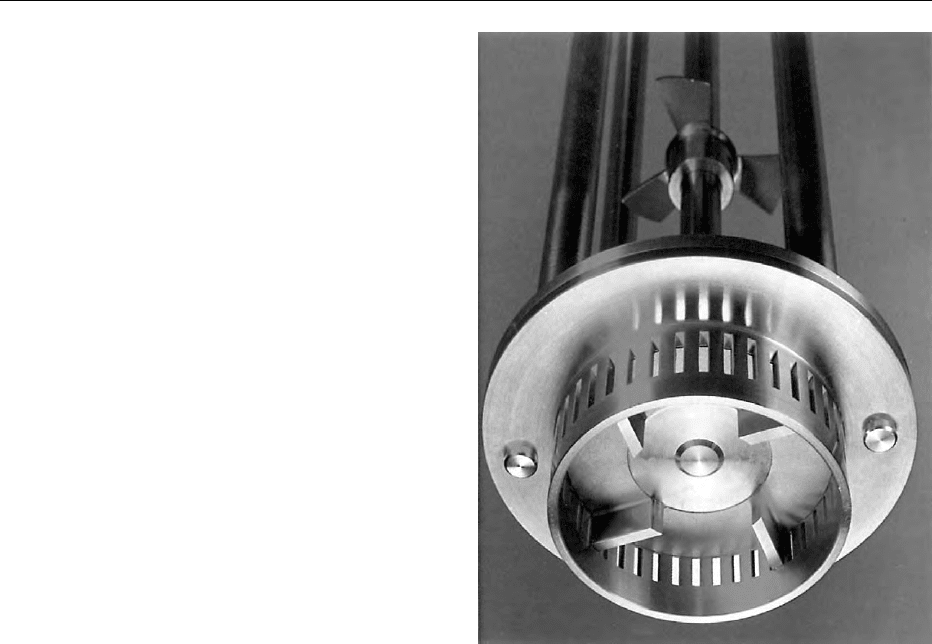
0002 The first treatment of milk to give a finer, more
stable, emulsion that would remain homogeneous
on standing has been attributed to Auguste Gaulin,
whose first patent was granted in 1899. High-pres-
sure homogenization is the most widely used method
for stabilizing milk and milk products. It has also
been widely used in other sectors of the food industry
and in the preparation of nonfood emulsions of low
to medium viscosity.
0003 The term ‘homogenization’ has since been applied
to similar emulsification processes, so that the terms
‘emulsification’ and ‘homogenization’ may often be
treated as synonyms rather than homogenization
being regarded as a specialized method of emulsifica-
tion. A wide range of equipment has been developed
for the homogenization of foodstuffs. The simplest
of these methods is the high-shear mixer, which
has been adapted for both batch and in-line process-
ing. The colloid mill has been widely used for the
homogenization of more viscous foodstuffs such
as sauces and mayonnaises. Emulsification may
also be the result of shear forces acting during other
food-preparation processes, such as the cooling of
margarine in scraped-surface heat exchangers, the
working of butter and in the use of pin mills and
disk mills.
0004 The formation of a stable homogeneous foodstuff
will depend on both the nature of the foodstuff and
the process. There is often an optimum viscosity of
the continuous phase for a given homogenizing tech-
nique, while lower viscosities in the disperse phase
will aid homogenization. The presence of surface-
active components may play a critical role in the
formation and maintenance of an emulsion. The
quantity of disperse phase will also affect the particle
size distribution in the emulsion. This article will
concentrate on the processes rather than the food
components.
High-shear Mixers
Batch Mixers
0005 High-shear mixers are commonly used for the batch
mixing of food ingredients and the formation of
emulsions. Most high-shear mixers rely on the devel-
opment of a shear gradient between the rapidly
rotating rotor and a static surface or stator. For
low-viscosity liquids, the rotor is normally a
simple turbine blade, and the stator is perforated.
Figure 1 illustrates a mixer with a vertical-slotted
disintegrating head that may also be used for break-
ing up fibrous tissue; a larger number of small square
or round holes would normally be used in the stator
screen for emulsification alone.
0006The mixer is normally coupled directly to an elec-
tric motor, wound to run at 2850 r.p.m. for small
mixers or at 1425 r.p.m. for large models, giving
rotor tip speeds of approximately 100–150 m s
1
for
pilot-scale applications. The flow of liquid from the
turbine is principally radial, the flow being obstructed
by the stator. Some liquid will pass between the rotor
tip and the stator: the smaller the clearance, the
greater the shear forces that will be developed. The
bulk of the liquid, however, will be forced through
the perforations in the rotor: the smaller the perfor-
ations, the greater the shear exerted on the mixture to
be emulsified.
0007With batch mixing, the mixer may be left running
until the desired homogenization/emulsification has
been achieved. This method is limited by the viscosity
of the foodstuff as adequate flow within the batch
mixing vessel is essential, and more viscous foods and
large batch sizes are better homogenized by other
techniques.
In-line Mixers
0008In-line mixers for homogenization use the same basic
principles as the batch mixers. In the simplest system,
fig0001Figure 1 Batch high-shear mixer (courtesy of Silverson
Machines Ltd).
3120 HOMOGENIZATION
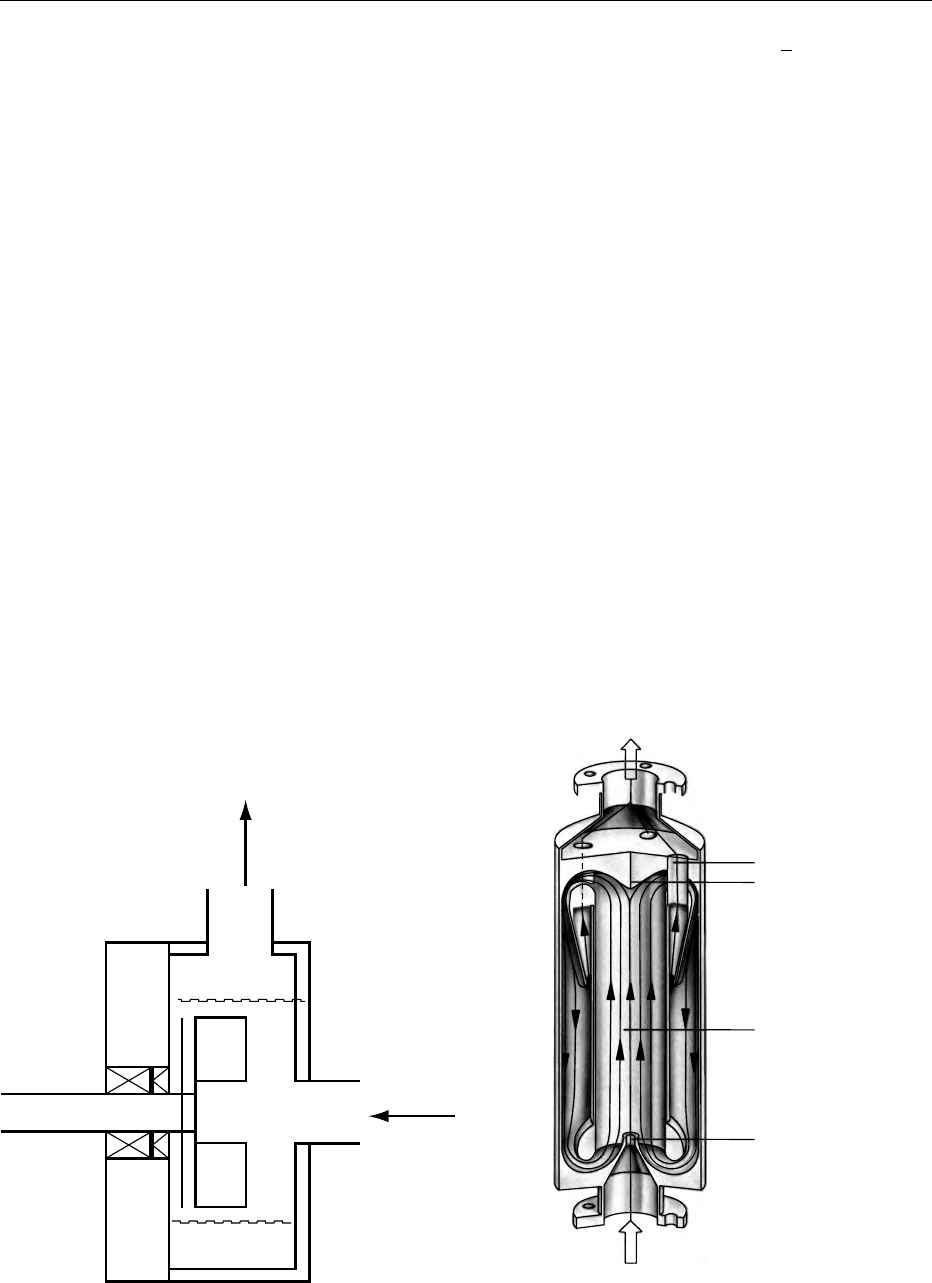
the liquid passes from the turbine through the screen
into an outer chamber and is discharged into the
pipeline without any recirculation (Figure 2). The
turbine has a weak pumping action. For some foods,
there may not be sufficient shear in one pass through
the homogenizing head so that either two or more
mixers need to be placed in series, or the mix recircu-
lated back to the feed tank until a sufficient degree of
emulsification has been achieved.
0009 Where recirculation needs to be carried out, this
may be incorporated into the design of the mixer by
allowing recirculation of part of the discharge from
the shear head back to the inlet. The degree of recir-
culation depends upon the mixer design; the type
shown in Figure 3 uses a high degree of recirculation
to ensure a homogeneous discharge.
Colloid Mill
0010 The colloid mill derives its emulsifying action from
the high shear on the foodstuff as it flows between the
rotor and stator, as illustrated in Figure 4. The rotor
may be coupled directly to a motor or driven via a
variable-speed gearbox. Typical rotor tip speeds are
20–50 ms
1
.
0011 Normally, the gap between the rotor and stator are
adjustable, typically between 100 and 200 mm, to
enable a range of shear rates and throughputs to be
achieved. The shear on the product will follow the
general relationship:
Shear stress T ¼
v
h
where m ¼ viscosity, v ¼ peripheral velocity, and h ¼
clearance.
0012Greater disruption may be achieved by using
toothed surfaces on the rotor and stator, e.g., for
peanut butter, though where a grinding action is
needed, a larger clearance may be used. The colloid
mill may be used as an in-line emulsifier and is par-
ticularly effective with viscous foodstuffs, though the
minimum particle size of the disperse phase (1–2 mm)
will not reach the submicron sizes that may be
achieved with the high-pressure homogenizer.
The High-pressure Homogenizer
0013The high-pressure homogenizer may be regarded as
comprising two parts: a high-pressure pump and one
or more homogenizing valves.
The High-pressure Pump
0014Pressure is used as the driving force for the homogen-
ization process, the liquid mixture to be homogenized
being raised to the homogenization pressure by a
positive displacement pump. In all but the smallest
pumps, there are at least three, sometimes five or
fig0002 Figure 2 Schematic section through an in-line high-shear
mixer.
Static Version
Exit pipes
Deflector
Mixing zone
Propulsive jet
fig0003Figure 3 Section through the mixing chamber and shearing
zone of a Burdosa Dynamic Loop Mixer (courtesy of dmt Gmbh,
Fischbach, Germany).
HOMOGENIZATION 3121
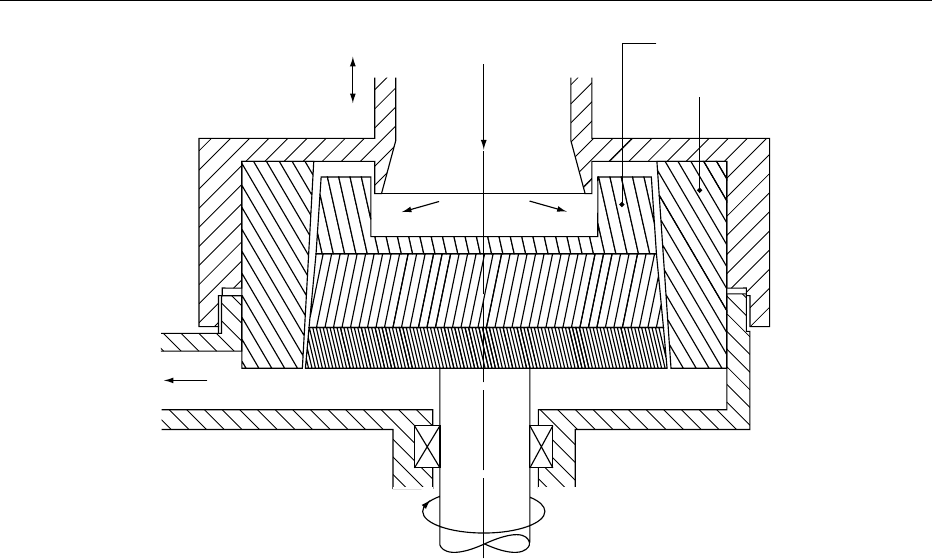
seven, pistons. The pistons must be arranged so that
they operate consecutively to maintain as even a feed
pressure as possible. Both the pistons and the pump
block are typically of stainless steel construction, but
the piston seal rings are of a soft composite material
and can be a source of cleaning problems. The layout
of the high-pressure pump is illustrated in Figure 5.
0015 The mixture to be homogenized is fed into the
pump block under a slight positive pressure. A gravity
feed is sufficient to ensure that the inlet valves
are flooded, but continuous operation may be better
served by feeding at a small positive pressure (e.g., up
to 0.1 MPa) from a centrifugal pump via a preheater.
0016 Two types of valve have been used in the pump
block, either ball valves or poppet valves, as illus-
trated in Figure 6. The upper, discharge, valves are
usually spring-loaded to ensure rapid closing.
0017 Ball valves have a smaller contact area with the
valve face, and they exert a greater pressure at the
point of contact. This is an advantage for viscous
liquids and when small particulates may be present
in the feed stock, since valve leakage is the limiting
factor in the high-pressure homogenization of liquids
containing suspended particles. Poppet valves need to
be fitted more carefully to the larger valve face, but,
when properly maintained, they have a better per-
formance with low-viscosity liquids such as milk.
0018 A third, mushroom, design of valve has been intro-
duced recently, designed as an optimum compromise
between the ball and poppet designs. Both inlet and
discharge valves are spring-loaded to ensure good
seating.
0019The mixture is discharged from the pumping cham-
bers of each piston into a high-pressure manifold. The
pressure in this manifold is normally monitored by a
pressure gauge, which must be of hygienic construc-
tion, with a diaphragm between the product and the
sensor mechanism, plus a means of cleaning the space
around the diaphragm. The only exit for product
from this high-pressure manifold is through the
homogenizing valve.
The Homogenizing Valve
0020Many designs of homogenizing valve have been
invented, but for most valves, the same basic prin-
ciples apply. The mixture, which must already be a
homogeneous mix and itself a coarse emulsion, flows
from the high-pressure manifold into the fixed valve
seat. The internal diameter of the valve seat is smaller
than the manifold, so the velocity of the liquid is
increased. To escape from the valve seat, the liquid
must flow radially across the face of the valve. The
gap between the valve face and the seat is controlled
so that a constant pressure drop across the valve is
maintained. The opposing force (operating pressure
times the valve area) may be provided by a heavy duty
spring, a torsion bar, hydraulic pressure or by direct
contact with a screw threaded lever. The basic design
Stator with
axial
adjustment
Inlet
Rotor
Stator
Outlet
Driving shaft
fig0004 Figure 4 Schematic section through a colloid mill (courtesy of Fryma Ltd, Hemel Hempstead, UK).
3122 HOMOGENIZATION
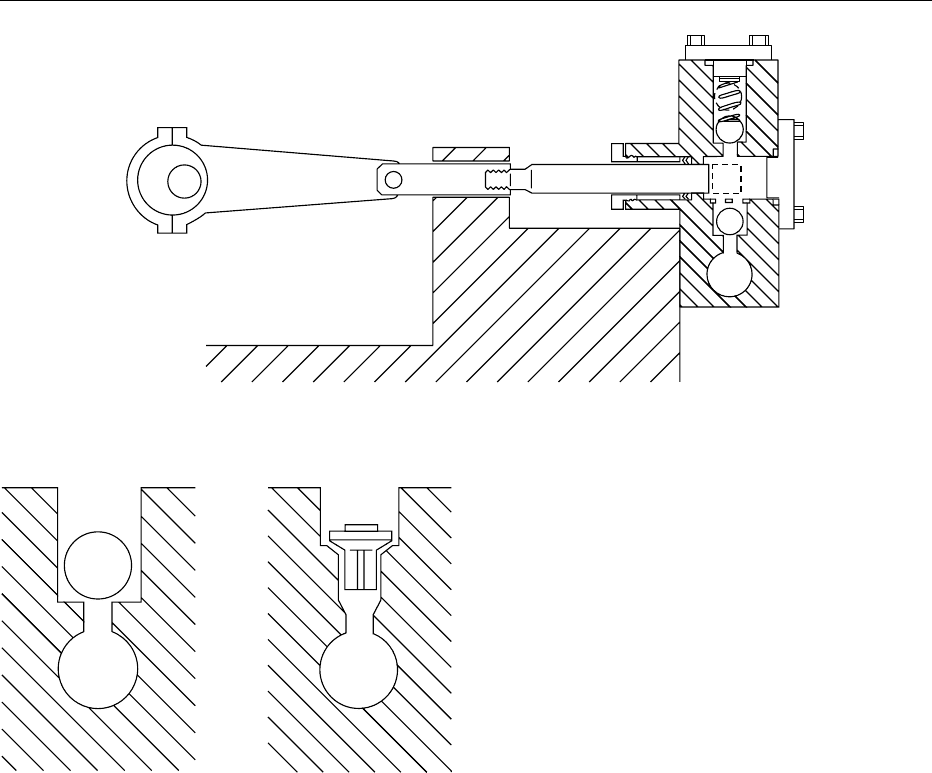
is illustrated in Figure 7. Pneumatic actuators have
been used in some machines with capacities of less
than 10 000 l h
1
, thus reducing the variance in
homogenization pressure. For most dairy products,
the homogenization pressure is in the range of 2.5–
30 MPa with throughputs of up to 50 000 l h
1
for
milk. Machines are available that will produce a feed
pressure of more than 100 MPa, though these are
restricted to lower throughputs by the power required
to drive them.
0021 The gap between the valve and its seat is many
times greater than the diameter of the droplets created
in the emulsion, e.g., in a normal large-scale dairy
application, the gap would be greater than 100 mm,
the size of the gap tending to increase with the
throughput of the machine. Even so, the cross-
sectional area of the flow path within the valve is
much smaller than that in the high-pressure manifold,
so the velocity of the liquid will rise as it enters the
valve. This acceleration can result in distortion of
the particles of the disperse phase (often called the
wire-drawing effect), which will reduce their stability.
Within the valve, there will be a number of effects on
the liquid that may contribute to the disruption of the
fat globules:
1.
0022Shear effects will result from the high velocity
gradients between the liquid and the surfaces of
the homogenizing valve. This effect, in combin-
ation with the wire-drawing effect, will lead to
disruption of globules.
2.
0023Turbulence also results from the high velocity of
the liquid in the valve, causing eddy currents
within the flow. High-velocity impacts between
particles can lead to disruption, and so increases
in velocity are associated with decreased fat
globule size in the case of oil-in-water emulsions.
3.
0024High-frequency vibrations (> 10 kHz) have been
observed in some valves that may be of mechanical
origin or a result of turbulence or cavitation. When
homogenizing at high temperature, the drop in
pressure as the liquid accelerates within the valve
may result in the pressure momentarily falling
below the saturation vapor pressure of an aqueous
continuous phase, leading to the formation of
steam bubbles. Collapse of these bubbles as the
pressure increases again sets up high-pressure
shock waves. Opinions vary about the contribution
of cavitation and other sources of vibration to the
overall disruptive effect during homogenization.
4.
0025Impact can contribute to the homogenizing effect
in some designs of homogenizing valve, where an
impact ring is placed perpendicular to the flow
of liquid from the valve. With valve exit velocities
of 200–300 m s
1
, there can be a significant
disruptive effect as the jet of emulsion impinges
on the ring.
fig0005 Figure 5 Schematic section of a high-pressure pump.
fig0006 Figure 6 Types of valve: (a) ball; (b) poppet.
HOMOGENIZATION 3123
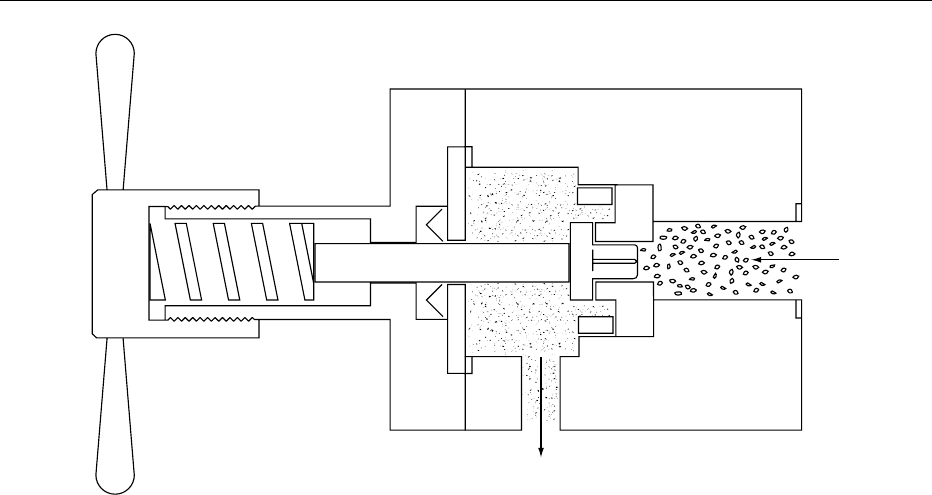
0026 Homogenizing valves have been produced from very
tough corrosion-resisting alloys such as stellite. A
better resistance to erosion may now be achieved
using tungsten carbide and ceramic valves, though
these are more difficult to produce and are more
fragile. A very wide range of homogenizing valve
designs using both single and multiple homogenizing
surfaces have been produced, with the aim of increas-
ing homogenization efficiency and thus reducing the
energy costs. Various claims for up to 30% energy
savings or a 40% reduction in homogenization pres-
sure for an equivalent size reduction with these new
designs have been made, in comparison with the
traditional Gaulin valve design.
Practical Considerations in the Use of
High-pressure Homogenizers
0027 Since homogenizers operate at high pressures, prob-
lems can be encountered with the seals. The pistons
are normally lubricated with potable water to minim-
ize wear of the rear seals, though in aseptic machines,
the pistons are also surrounded by a steam seal to
avoid product contamination. With nonaseptic ma-
chines, the homogenization step is normally carried
out prior to the heat treatment to minimize hygiene
risks. Icecream mix may be homogenized at the heat
treatment temperature (66–80
C). In general, the
efficiency of a high-pressure homogenizer increases
with temperature, but temperature is normally
limited by the product.
0028 Constant homogenizing pressure is necessary
for efficient reproducible emulsification. Rapidly
fluctuating pressure may be due to a faulty gauge,
but the most common cause is poor seating of the
valves. Seating problems can result from wear, from
incorrect placement of valves in the seatings, or from
dirt or foreign bodies on the seats. The presence of air
in the feed can also cause problems, and deaeration
may be needed in some processes prior to homogen-
ization.
0029With many dairy emulsions, the fine particles pro-
duced by homogenization tend to flocculate. These
flocculated globules behave as large particles and
separate from the emulsion. The introduction of a
second homogenization stage or a multistage valve
can overcome this problem. The pressure drop across
the second stage valve should be relatively small,
typically 3–5 MPa, to break up the aggregates. With
two-stage homogenization, it is common practice to
set the second-stage pressure first then to set up the
first stage, remembering that the gauge will indicate
the total pressure. The introduction of a second pres-
sure gauge between the first- and second-stage valves
aids control of the process. Where very find disper-
sions are desired, multiple high-pressure homogeniza-
tion has been used.
Other Emulsifying Systems
0030Ultrasonic homogenization uses a transducer or a
mechanical wedge to generate high-frequency vibra-
tions at over 10 kHz, typically 18–50 kHz, so that the
output is barely audible. These give rise to shock
waves plus possibly cavitation in the mixture.
fig0007 Figure 7 Schematic section through a homogenizing valve assembly.
3124 HOMOGENIZATION

Efficiency declines with increasing frequency, the
upper limit being about 50 kHz. It has been suggested
that the efficiency of the process is increased by intro-
ducing or creating microbubbles or particles that
resonate with the frequencies generated in the appar-
atus. The transducer method has been used on a small
scale for producing emulsions and for disrupting cells,
whereas the wedge method has been used for emulsi-
fication in food products
0031 Emulsification may also be achieved by mixing
high-speed streams of the two phases, the resultant
mixture then being forced through a small orifice to
create a high-velocity impinging jet. This method,
known as microfluidization, is essentially a modifica-
tion of the high-pressure homogenizer principle but
can be employed for very small sample sizes.
0032 As with other methods, there can be considerable
heat production.
0033 Part of this article was first published in the Journal
of the Society of Dairy Technology, Volume 45 (1992)
and was reproduced by the kind permission of the
Society of Dairy Technology.
See also: Colloids and Emulsions; Emulsifiers: Organic
Emulsifiers; Phosphates as Meat Emulsion Stabilizers;
Uses in Processed Foods; Ice Cream: Microbiology;
Separation and Clarification
Further Reading
Brennan JG, Butters JR, Cowell ND and Lilley AEV (1990)
Food Engineering Operations, 3rd edn. London:
Elsevier Applied Science.
Kessler HG (1981) Food Engineering & Dairy Technology.
Freising: Ferlag A. Kessler.
McClements DJ (1999) Food Emulsions; Principles, Prac-
tice and Techniques. Boca Raton, FL: CRC Press.
Phipps LW (1985) The High Pressure Dairy Homogenizer.
Reading, UK: National Institute for Research in Dairy-
ing.
Walstra P (1985) Formation of emulsions. In: Becher P (ed.)
Encyclopaedia of Emulsion Technology, vol. 1, pp. 57–
127. New York: Marcel Dekker.
Walstra P, Gearts TJ, Noomen A, Jellema A and van Boekel
MAJS (1999) Dairy Technology. Marcel Dekker, New
York.
HONEY
L W Doner, US Department of Agriculture, Wyndmoor,
PA, USA
Copyright 2003, Elsevier Science Ltd. All Rights Reserved.
Background
0001 Honey serves to assure the survival of honeybee
colonies and, consequently, the pollination and sur-
vival of many plants. It was one of man’s earliest
foods, as honeybees were producing it long before
man appeared on the earth. Honey remained the
primary sweetener for humans until the late nine-
teenth century, when its consumption was exceeded
by sugar cane-, sugar beet-, and later corn-derived
sugars. Honey remains the only sweetener that can
be stored and used precisely as it is produced by
nature. It is an exceedingly complex substance that
is produced by honeybees from floral nectar and,
less frequently, honeydew. Honeydew consists of
syrups deposited on plants by other insects, such as
aphids. Whereas nectar from the many floral sources
generally contains just the sugars fructose, glucose,
and sucrose, honey contains these and many other
more complex sugars. The additional sugars arise
largely as a result of honeybees adding several
enzymes during the nectar-to-honey ripening pro-
cess. The presence of active enzymes and the acidity
of honey result in its composition being in a con-
stant state of change.
0002Comprehensive surveys of average honey compos-
ition have established that the major components
are fructose (38.4%), glucose (30.3%), and water
(17.2%). In addition to the two major sugars are an
array of more than 20 higher sugars, which are
formed by linking the fructose and glucose in various
combinations. Honey is therefore primarily a carbo-
hydrate material, and sugars comprise over 95%
of its solids content. The principal physical character-
istics of honey are due to its sugars, but subtle
differences in minor constituents from nectar are re-
sponsible for the flavor differences of honey from
different floral sources. These constituents include
flavoring and aroma compounds, pigments, acids,
and minerals. These substances are concentrated
during the ripening process, where most of the
water from nectar is removed. In order to assure
the integrity of honey markets, methods have been
developed to detect the addition of inexpensive sugar
mixtures as adulterants.
HONEY 3125

Honey Production and Processing
0003 To summarize, foraging honeybees ingest nectar and
honeydew and store it in their honey sac. Pollen is
also collected, and this provides the protein portion of
the honeybee diet. Pollen, however, is not integral
to the production of honey. The honey sac weighs
40–70 mg when full and can account for more than
90% of the weight of the bee. Enzymes are secreted
and mixed with the sac contents. Upon returning to
the hive, the contents are passed on to the house bees,
who carry out the ripening process. This consists of
alternately expelling and ingesting the honey sac fluid
for 15–20 min. When the nectar has lost about half of
its moisture, small droplets of this semiripened honey
are deposited in the comb cells. In 1–3 days, numer-
ous enzyme-mediated changes will have occurred and
honey density attained. The cells are then capped over
with wax and the honey stored as food. Compos-
itional changes continue during ripening, the most
prominent result being the production of an increas-
ingly complex array of sugars. This is largely a result
of continuing enzyme activity. An enzymatic process
is also employed to produce hydrogen peroxide, in
order to stabilize the honey against microbial growth.
0004 The primary objectives of commercial honey pro-
cessing include maintaining the desired physical state,
be it liquid or finely granulated, and keeping it free of
fermentation. Methods for accomplishing the object-
ives are well established and have been used for many
years. Beekeepers remove the hive units (supers) from
the colony and then remove the wax cappings by
mechanical slicing. The honey is then centrifugally
extracted from the wax comb. Raw honey contains
pollen, some wax, sugar-tolerant yeasts, and often
some crystals of glucose monohydrate. Flavor and
aroma are optimal just after processing, but further
treatment is required before large-scale marketing.
The process of pressure filtration is used to produce
liquid honey, after controlled heating to destroy
yeasts and to dissolve sugar crystals. The application
of heat to honey requires careful control so that the
color, flavor, and aroma of honey are not impaired.
Honey is sold in the liquid form, in a finely granu-
lated form known as honey spread or finely
granulated honey, and as comb honey. The require-
ments for the stability of these forms are increasingly
stringent, as honey has become a world commodity
available in markets throughout the year.
0005 World honey production has increased steadily
and, in the year 2000, was estimated to be about
1.2 million tonnes. About 25% of this production is
the object of international trade. The three largest
honey-exporting countries are China, Argentina,
and Mexico, and the largest importers are Germany,
Japan, and the USA. The USA is the leading consumer
of honey, and honey consumption in Asia has in-
creased substantially in recent years, especially in
Japan and China.
General Composition
0006Honey samples vary in composition, and this vari-
ability reflects contributions of the plant source of
nectar, beekeeping practices, and climate and envir-
onmental conditions. Honeys representing many
floral sources in the USA have been analyzed, and
the average compositions are listed in Table 1.
Many honeys from other countries have been
analyzed and generally found to provide similar
values. There is wide variability among all the honey
components. Among the major components, how-
ever, fructose levels exceed those of glucose, the only
exceptions being dandelion and blue curls honeys.
Moisture
0007Moisture content is one of the most important char-
acteristics of honey, as it influences the keeping qual-
ity, granulation, and body. The natural moisture of
honey in the comb is that remaining from the nectar
after it is ripened by the bees. The amount of moisture
is a function of factors involved in ripening, such
as environmental conditions, original moisture con-
tent of the nectar, and strength of the honeybee
colony. Normal ripened honey has a moisture content
below 18.6%, and when the moisture content
exceeds that level, honeys are liable to ferment. This
can occur if the count of ubiquitous osmophilic
yeasts is sufficiently high. After extraction of the
honey from the comb, its moisture content may
change, depending on the conditions of storage.
Low moisture levels can result in the crystallization
of glucose, a process termed granulation. Few
tbl0001Table 1 Average composition of honey
a
Property Average Range
Moisture 17.2 12.2–22.9
Fructose 38.4 30.9–44.3
Glucose 30.3 22.9–40.7
Sucrose 1.3 0.2–7.6
‘Maltose’
a
7.3 2.7–16.0
Higher sugars 1.4 0.1–3.8
Ash 0.17 0.02–1.03
Nitrogen 0.04 0.0–0.13
pH 3.91 3.4–6.1
a
Data for 490 samples; all values in percentages except for pH; ‘maltose’
includes all reducing disaccharides.
From White JW, Jr. (1962) Composition of American Honeys. Technical
Bulletin No. 1261. US Department of Agriculture.
3126 HONEY

beekeepers measure the moisture content of honey,
instead relying on guesswork and leaving this meas-
urement to processors.
0008 Several methods are available to measure honey
moisture, including direct drying, viscosity measure-
ment, refractometry, and use of the Karl Fischer titra-
tion method. The last method is the most accurate,
but the hand refractometer is sufficiently accurate
and more convenient to use. This instrument must be
used with appropriate sugar solutions as standards.
Sugars
0009 The simple sugars fructose and glucose account for
over 85% of its solids, so honey is essentially a highly
concentrated sugar solution in water. Another 10% of
the honey solids includes at least 25 other more com-
plex sugars (Table 2), giving it the most complex
sugar profile of any natural product. Some of these
sugars are present in very low levels, and they are
formed by linking fructose and glucose in many dif-
ferent combinations.
0010 Until the middle of the twentieth century, the only
sugars thought to be present in honey were the nectar
sugars fructose, glucose, and sucrose, and small
amounts of an ill-defined, highly complex carbohy-
drate. After the ill-defined material was shown to
consist of many individual sugars, researchers pro-
vided some explanations as to how they could arise
from the nectar raw material. It was revealed that
while the acids of honey may be responsible for gen-
erating some of the sugars, most are generated as a
result of the action of enzymes contributed by the
honeybees during the ripening process. The enzym-
atic formation of these sugars is discussed in the
following section on the honey enzymes.
0011 A variety of methods have been required to charac-
terize the many honey sugars. Traditional colorimet-
ric methods continue to be useful for determining
levels of reducing and nonreducing sugars in honey,
but these methods do little to reveal the high degree of
complexity. Enzymatic methods can also be used,
such as glucose oxidase for measuring glucose levels.
Beginning in about 1950, various chromatographic
methods have been shown to be extremely useful.
Charcoal-celite chromatography continues to be
applied for separating the honey sugars into mono-,
di-, and higher saccharide fractions. These fractions
are then further resolved using paper-, charcoal-celite
column-, thin-layer-, high-performance liquid-,
capillary gas-liquid-, and high-performance anion
exchange chromatography. The latter two chromato-
graphic modes have been especially useful in separat-
ing closely related sugars. After their purification,
physical methods such as infrared and nuclear
magnetic resonance spectroscopy have been applied
to identifying the sugars listed in Table 2 as com-
ponents of honey. Some of these are present at
extremely low levels, providing additional challenges
to the analyst. (See Fructose; Glucose: Properties and
Analysis; Sucrose: Properties and Determination.)
Enzymes
0012Enzymes that have been identified as honey compon-
ents are listed in Table 3, along with the number of
samples analyzed. These are mostly added by the
honeybee, although some traces of plant enzymes
may be present. Honeybees add these enzymes in
order to accomplish the nectar-to-honey ripening pro-
cess, and they are largely responsible for providing
the compositional complexity of honey. The pro-
cesses involved in the conversion of the three nectar
sugars into at least 25 additional sugars of greater
complexity are far from being totally understood. It
is becoming increasingly clear, however, that enzyme-
catalyzed reactions are responsible for the formation
of many of these sugars.
tbl0002 Table 2 Sugars that have been identified as honey constituents
Monosaccharides Disaccharides Trisaccharides Higher saccharides
Fructose Sucrose Melezitose Isomaltotetraose
Glucose Maltose Maltotriose Isomaltopentaose
Maltulose Isomaltotriose
Isomaltose 3-a-Isomaltosyl glucose
Nigerose 1-Kestose
Turanose Panose
Kojibiose Isopanose
Laminaribiose Erlose
a,b-Trehalose Theanderose
Gentiobiose Centose
Palatinose Laminaritriose
Cellobiose
From Doner LW (1977) The sugars of honey – A review. Journal of the Science of Food and Agriculture 28: 443–456.
HONEY 3127

0013 The enzyme a-glucosidase is probably the most sig-
nificant honey enzyme, since it is responsible for many
of the important changes that occur during riping. It is
often referred to as invertase or sucrase in the honey
literature. a-Glucosidase converts the nectar disac-
charide sucrose into its constituent monosaccharides,
fructose and glucose, a process known as inversion.
This reaction is vital because sucrose crystallizes easily
and also because its inversion allows the preparation of
the super-saturated glucose/fructose mixture found in
honey. a-Glucosidase catalyzes additional reactions,
leading to the formation of several addition sugars.
Researchers have found that incubation of the enzyme
with fructose, glucose, and sucrose results in sugars not
from hydrolysis reactions but from transglucosylation
reactions. By this process, higher sugars are produced
from simpler sugars. Sugars from Table 2 that have
been identified are kojibiose, nigerose, maltose, iso-
maltose, turanose, a, b-trehalose, and erlose. The tri-
saccharide erlose was first discovered as a honey
component, and is formed by the reaction of glucose
with the glucose moiety of the disaccharide sucrose.
0014 When the most recently discovered honey enzyme,
b-glucosidase, has been incubated with fructose, glu-
cose, and sucrose, other honey sugars have resulted.
These were the glucose–glucose disaccharides, lami-
naribiose and gentiobiose. Thus, at least nine of the
honey sugars are produced by the action of a-and
b-glucosidase on the nectar sugars. The mode of for-
mation of most of the honey trisaccharides remains to
be elucidated.
0015 Another honey enzyme contributed by the honey-
bee, glucose oxidase, is largely responsible for the anti-
bacterial property of honey. This activity was termed
inhibine until it was identified to be hydrogen perox-
ide. This antibacterial agent is produced by the action
of glucose oxidase on its glucose substrate. In addition
to hydrogen peroxide, gluconic acid is produced by the
enzyme. The acidity of this sugar acid is largely respon-
sible for the low pH of honey. In conjunction with the
high solids content and resulting low water activity, it
helps to stabilize honey against fermentation.
0016The honey enzymes catalase and acid phosphatase
have not been studied in great detail. Catalase was
discovered in honey in 1910 and is responsible for
converting hydrogen peroxide into water and oxygen.
The role of this enzyme appears to be in controlling
the levels of hydrogen peroxide in honey, since there is
an inverse relationship between the levels of enzyme
and substrate.
0017Acid phosphatase was first reported in 1938 when
incubation of b-glycerophosphate with diluted honey
was found to result in formation of phosphoric acid
and glycerol. The source of this enzyme is unclear.
One study suggested that it is only present in slightly
fermented honey samples and that yeast is the prob-
able source. A more recent study suggested a plant
source for acid phosphatases, since activities were
found in pollen and nectar.
0018Diastase enzyme is added to nectar by bees during
ripening, and is a mixture of a- and b-amylase. These
enzymes are known to degrade starch, but since
nectars are not known to contain starch, their role
during ripening is unknown. The activity of honey
diastase is known to be reduced upon heating and is
easily measured. As a result, its measurement has
been used for many years to estimate the extent of
heating to which a honey has been exposed. This
information is used in countries where such heating
is believed to reduce or deplete certain ill-defined
health-promoting properties. A problem with this
approach is that diastase levels in fresh honeys vary
considerably, and extended storage can significantly
deplete its level. (See Enzymes: Functions and Char-
acteristics.)
Minerals
0019The mineral content of honey is reflected in its total
ash content (Table 1). In general, dark honeys have a
higher mineral content than light honeys. Like other
honey components, ash content is highly variable,
ranging from 0.02% to over 1%. The levels of indi-
vidual minerals that comprise the ash are also vari-
able, but potassium accounts for about one-third of
the total amount. Its level exceeds by about 10-fold
that of the other major minerals in honey, sodium,
calcium, and magnesium. Less abundant elements
found in honey are iron, manganese, copper, chlorine,
phosphorus, sulfur, and silicon. Sensitive instrumen-
tal methods such as atomic absorption or plasma
emission spectroscopic analysis can be used to accur-
ately determine levels of even the most trace minerals.
Acids
0020The great sweetness of honey largely masks flavor
contributions of the acids, which generally account
tbl0003 Table 3 Enzymes that have been identified as honey
constituents
Enzyme Number of samples
a-Glucosidase 1468
b-Glucosidase 11
Glucose oxidase 124
Catalase 38
Acid phosphatase 25
a-Amylase 1746
b-Amylase 1746
From Doner LW (1991) The enzymes of honey. In: Fox PF (ed.) Food
Enzymology, pp. 143–161. London: Elsevier Applied Science.
3128 HONEY
